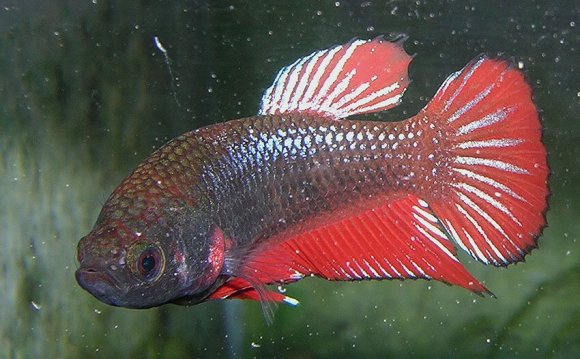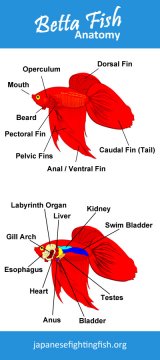
So wondering how each part of these beautiful fish come together to create the little guy you love? In this article I would like to go through the betta fish anatomy diagrams below and point out some of the key body parts of a betta.

Body shape
Betta fish have a very streamlined body shape. This allowed the wild bettas to swim fast and effectively through the water and to catch prey.
Betta’s mouth
You may have noticed that the mouth of a betta fish is upturned this allows it to catch prey on the surface of the water (such as mosquito larvae and other small insects). The mouth of the betta does also contain tiny teeth, nothing that could harm a human but a bloodworm on the other hand… well you will soon see a fighting fish!
Scales
The tiny scales are there to protect the betta fish’s body and aid in swimming.
Additional protection comes from a mucus layer on top of the fins – this aids in the protection of diseases and parasites. If you have ever handled your fish you may have felt this slimy layer. However, it is important that you do not handle your fish too much as if you affect the mucus layer you leave your fish more prone to diseases and parasites.
Betta fish scales are transparent the beautiful and vibrant colors actually come from the skin below.
Fins
The fins of a fish are used to maneuver through the water, keep stable and maintain balance.
The caudal fin (back betta fish tail) is the fin that is used to propel the fish forward providing the force for sudden burst of speed.
Selective breeding over the years has lengthened the caudal fin. These longer delicate and beautiful betta fish tails we now know have however slowed down the movement of the domestic betta fish in comparison to its wild ancestors.
Dorsal fin and anal fin are there to provide stability to the fish.
Pectoral Fins also provide stability and help the fish to steer along with the pelvic fins.
Gills
As with all fish the gills are used to extract the oxygen from the water.
Water goes through the mouth and then across the gills. Blood flowing through the capillaries of the gills absorb the oxygen from the water.
Eyes
The betta fish’s eyes are there obviously for vision / sight. A betta fish’s vision is called monocular vision. This means that their eyes are on the opposite sides of their head and both eyes produce a different image. Their eyes do not react well to quick changes in brightness and they can focus on objects up to a foot away.
Labyrinth Organ
The betta is one of the few fish with a labyrinth organ. This organ allows the betta fish to take oxygen from the air above the water’s surface. This organ has been evolved through the water conditions betta fish have lived in in the wild. Many of the shallow streams, swamps or rice paddies that betta fish have evolved in would dry up, creating small pockets of poorly oxygenated water that the fish needed to survive in.
The labyrinth organ allows the air which the fish takes from the surface to be directly absorbed into the blood stream. Pretty cool for a fish!
This organ needs to be able to be used by the betta from time to time. Please ensure your water level / tank lid allows the fish to come to the surface for a breath of air while also baring in mind that bettas can jump!
Swim Bladder
The function of this bladder is basically to be a floatation device. The betta fish fills this with gas so that it can control its buoyancy. The swim bladder can become affected when the betta fish is bloated / constipated / over fed. Once this organ is affected it is hard for the betta fish to get to the top of the tank to take in air and get food (or sometimes hard for your betta to leave the top of the tank).
Stomach
The betta fish has a tiny stomach, around the size of its eye. Please do not over feed your fish as it can cause swim bladder disorder. Many owners advise a day without feeding every week or so to aid the digestion of the food and to reduce risk of bloating and constipation.
Subscribe today and receive a FREE Betta Fish Care for Beginners eBook
Are you a little betta fish crazy? Join over 4200 members and subscribe to our email newsletters for betta fish care tips, betta fish fun and a free betta fish care book.
Thank you for subscribing.









